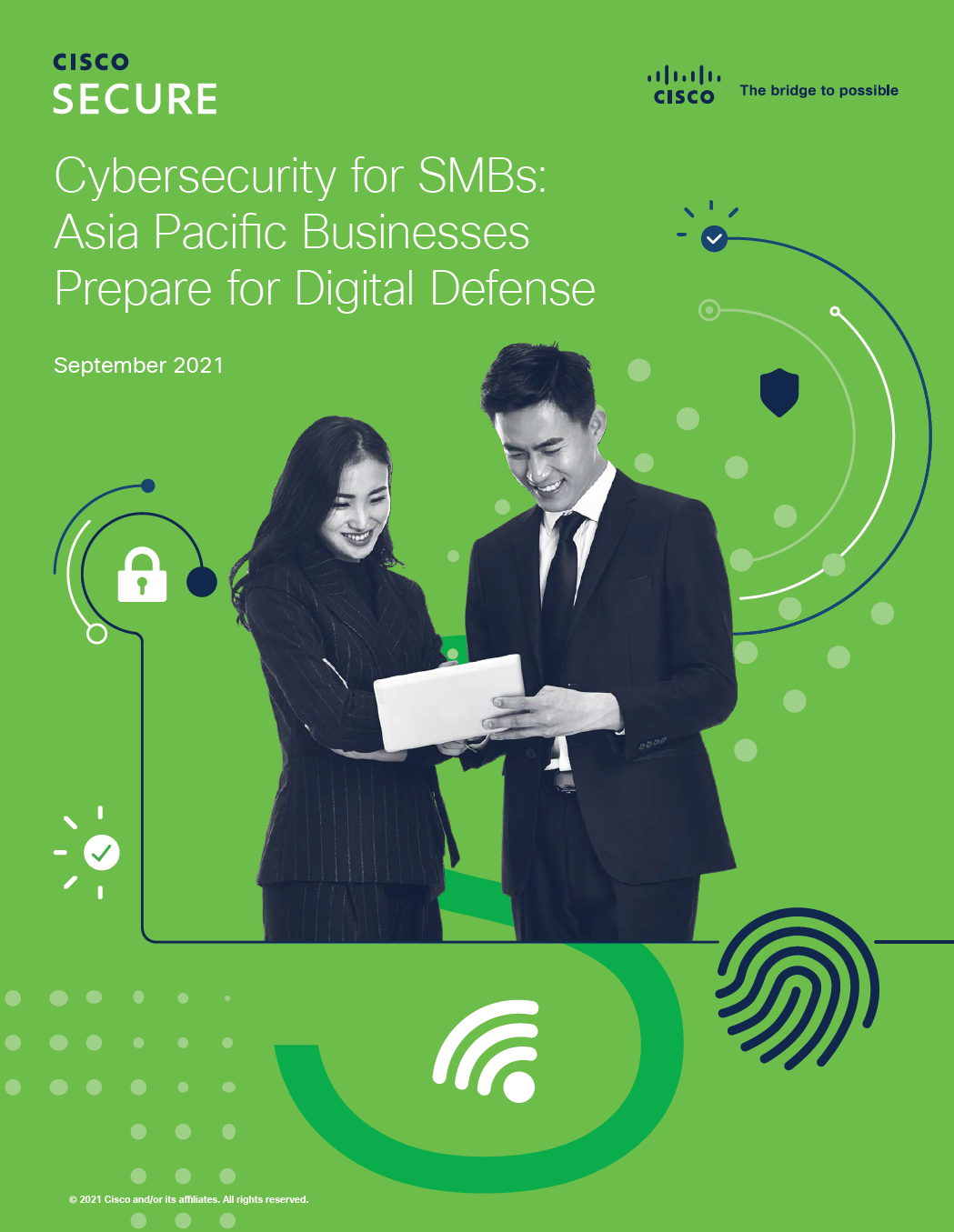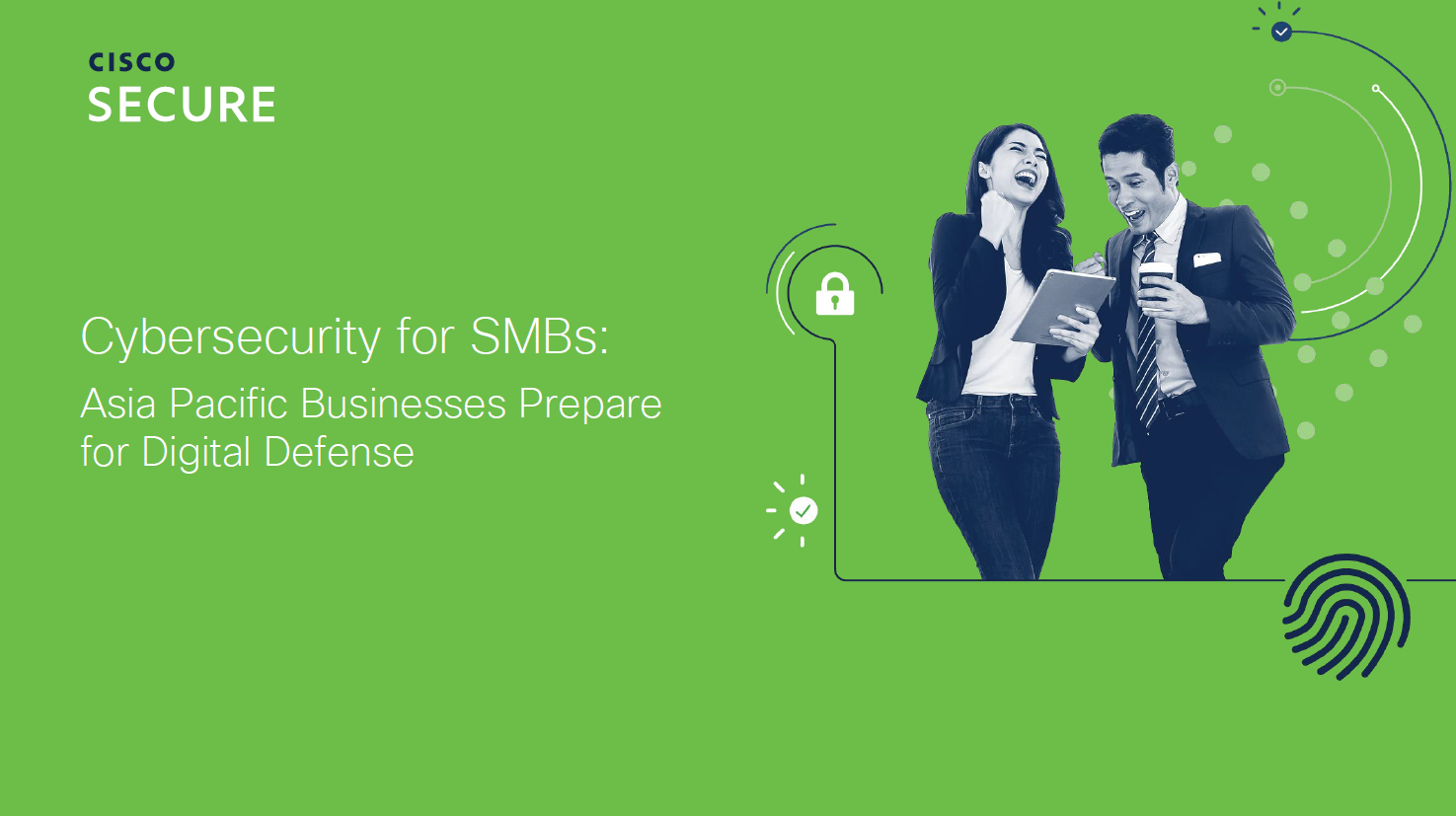- เอสเอ็มอีไทย 65% ถูกโจมตีทางไซเบอร์ในช่วง 12 เดือนที่ผ่านมา
- 47% ของเอสเอ็มอีที่ถูกโจมตีทางไซเบอร์ได้รับความเสียหายทางธุรกิจกว่า 500,000 ดอลลาร์สหรัฐ (ประมาณ 16 ล้านบาท) หรือมากกว่านั้น
- เอสเอ็มอีเตรียมรับมือกับปัญหานี้ โดย 95% สร้างแบบจำลองภัยคุกคามทางไซเบอร์ (simulated cybersecurity) เพื่อซ้อมรับมือกับการโจมตีในช่วง 12 เดือนที่ผ่านมา
ผลการศึกษาล่าสุดของซิสโก้ชี้ว่า ธุรกิจขนาดกลางและขนาดเล็ก หรือเอสเอ็มอีในไทยกำลังเผชิญกับความเสี่ยงหรือถูกโจมตีทางไซเบอร์ และมีความกังวลเกี่ยวกับภัยคุกคามด้านไซเบอร์ซีเคียวริตี้มากขึ้นอย่างที่ไม่เคยมีมาก่อน โดย 65% ของเอสเอ็มอีในไทยถูกโจมตีทางไซเบอร์ในปีที่ผ่านมา และ 76% สูญเสียข้อมูลลูกค้าหลังถูกโจมตีทางไซเบอร์
ด้วยเหตุนี้ เอสเอ็มอีจึงมีความวิตกกังวลมากขึ้นเกี่ยวกับความเสี่ยงทางด้านไซเบอร์ซีเคียวริตี้ โดย 76% ระบุว่า ปัจจุบันมีความกังวลเรื่องไซเบอร์ซีเคียวริตี้มากกว่าเมื่อ 12 เดือนที่แล้ว และ 97% รู้สึกว่าตกอยู่ในความเสี่ยงต่อภัยคุกคามทางไซเบอร์ อย่างไรก็ตาม เอสเอ็มอีในภูมิภาคนี้ไม่ยอมแพ้ต่อปัญหา โดยผลการศึกษาของซิสโก้ชี้ว่า เอสเอ็มอีกำลังดำเนินมาตรการอย่างจริงจังในหลายๆ ด้าน เช่น การสร้างแบบจำลองภัยคุกคามทางไซเบอร์ เพื่อซ้อมรับมือกับการโจมตีและปรับปรุงความสามารถในการป้องกันภัยไซเบอร์

รายงานผลการศึกษา: ไซเบอร์ซีเคียวริตี้สำหรับเอสเอ็มอี: การเตรียมพร้อมขององค์กรธุรกิจในเอเชีย-แปซิฟิกสำหรับการป้องกันภัยทางดิจิทัล (Cybersecurity for SMBs: Asia Pacific Businesses Prepare for Digital Defense) อ้างอิงผลการสำรวจความคิดเห็นแบบ double-blinded ของผู้บริหารธุรกิจ และผู้บริหารไอทีที่ดูแลเรื่องไซเบอร์ซีเคียวริตี้กว่า 3,700 คนจาก 14 ประเทศในเอเชีย-แปซิฟิก ผลสำรวจชี้ว่าเอสเอ็มอีในไทยได้เผชิญหลากหลายวิธีการที่คนร้ายใช้ในการเจาะเข้าสู่ระบบขององค์กร ซึ่งการโจมตีด้วยมัลแวร์ ครองอันดับหนึ่งในไทย ส่งผลกระทบต่อเอสเอ็มอี 91% ตามด้วยฟิชชิ่ง (Phishing) 77% ในปีที่ผ่านมา
เอสเอ็มอีในไทยเกือบครึ่งหนึ่ง (49%) ที่ถูกโจมตีทางไซเบอร์ระบุว่า สาเหตุสำคัญที่สุดที่ทำให้องค์กรถูกโจมตีเป็นเพราะว่าโซลูชั่นด้านไซเบอร์ซีเคียวริตี้ไม่มีประสิทธิภาพเพียงพอที่จะตรวจจับ หรือป้องกันการโจมตี ขณะที่ 25% ระบุว่าสาเหตุหลักคือองค์กรไม่ได้ติดตั้งโซลูชั่นด้านไซเบอร์ซีเคียวริตี้ และไม่ได้ให้ความสำคัญเป็นอันดับแรกๆ
ปัญหาดังกล่าวส่งผลเสียอย่างมากต่อธุรกิจ โดยเกือบครึ่งหนึ่ง (47%) ของเอสเอ็มอีในไทยที่เคยถูกโจมตีทางไซเบอร์ช่วง 12 เดือนที่ผ่านมาระบุว่าเหตุการณ์ดังกล่าวสร้างความเสียหายต่อธุรกิจคิดเป็นมูลค่าอย่างน้อย 500,000 ดอลลาร์ (ประมาณ 16 ล้านบาท) ขณะที่ 28% ได้รับความเสียหาย 1 ล้านดอลลาร์ (ประมาณ 32 ล้านบาท) หรือมากกว่านั้น
นายทวีวัฒน์ จันทรเสโน กรรมการผู้จัดการ ซิสโก้ ประเทศไทย กล่าวว่า “เอสเอ็มอีในไทยเร่งดำเนินการปรับเปลี่ยนธุรกิจสู่ดิจิทัลในช่วง 18 เดือนที่ผ่านมา เพื่อให้สามารถใช้ประโยชน์จากเทคโนโลยีสำหรับการดำเนินงานอย่างต่อเนื่อง และตอบสนองความต้องการของลูกค้าโดยเป็นผลมาจากการแพร่ระบาด การปรับเปลี่ยนสู่ดิจิทัลดังกล่าวทำให้เอสเอ็มอีจำเป็นต้องลงทุนในเทคโนโลยีและโซลูชั่นที่จะช่วยปกป้ององค์กรให้รอดพ้นจากภัยคุกคามด้านไซเบอร์ซีเคียวริตี้ ทั้งนี้เพราะยิ่งธุรกิจเป็นรูปแบบดิจิทัลมากเท่าไร ก็จะยิ่งตกเป็นเป้าหมายการโจมตีของคนร้ายมากขึ้นเท่านั้น”
นอกเหนือจากการสูญเสียข้อมูลลูกค้าแล้ว เอสเอ็มอีในไทยที่ถูกโจมตียังสูญเสียข้อมูลของพนักงาน (69%), อีเมลภายในองค์กร (65%), ทรัพย์สินทางปัญญา (53%), ข้อมูลด้านการเงิน (57%) และข้อมูลธุรกิจที่สำคัญ (49%) นอกจากนี้ 56% ประสบปัญหาการดำเนินงานหยุดชะงักอันเนื่องมาจากการโจมตีทางไซเบอร์
การหยุดชะงักของธุรกิจที่เป็นผลมาจากการโจมตีทางไซเบอร์อาจก่อให้เกิดผลกระทบอย่างร้ายแรงต่อเอสเอ็มอี โดยกว่า 8 ใน 10 (81%) ของเอสเอ็มอีในไทยระบุว่า การที่ระบบใดก็ตามหยุดทำงานเกินกว่าหนึ่งชั่วโมงจะทำให้การดำเนินธุรกิจหยุดชะงักอย่างรุนแรง และ 86% ระบุว่ากรณีเช่นนี้จะส่งผลให้องค์กรสูญเสียรายได้ และยิ่งไปกว่านั้น 29% ระบุว่า ถ้าระบบหยุดทำงานเกินกว่าหนึ่งวัน จะทำให้องค์กรต้องยุติการดำเนินงานอย่างถาวร
ปัญหาท้าทายนี้มีขอบเขตและระดับความรุนแรงเพิ่มมากขึ้นเนื่องจากมีผู้ตอบแบบสอบถามในไทยเพียง 13% เท่านั้นที่ระบุว่าตนเองสามารถตรวจจับการโจมตีทางไซเบอร์ได้ภายในหนึ่งชั่วโมง และจำนวนองค์กรที่สามารถแก้ไขปัญหาการโจมตีทางไซเบอร์ได้ภายในหนึ่งชั่วโมงอยู่ที่ 7% เท่านั้น
จวน ฮวด คู ผู้อำนวยการฝ่ายไซเบอร์ซีเคียวริตี้ประจำภูมิภาคอาเซียนของซิสโก้ กล่าวว่า “ทุกวันนี้ ลูกค้าต้องการการตอบสนองและบริการที่ฉับไว และไม่มีความอดทนในการรอคอยกรณีที่ระบบหยุดทำงานเป็นระยะเวลานาน ดังนั้นจึงจำเป็นอย่างยิ่งที่เอสเอ็มอีจะต้องสามารถตรวจจับ ตรวจสอบ และสกัดกั้นหรือแก้ไขปัญหาการโจมตีทางไซเบอร์ให้เร็วที่สุดเท่าที่จะเป็นไปได้ ซึ่งการที่สามารถทำเช่นนั้นได้ จะต้องอาศัยโซลูชั่นที่ติดตั้ง และใช้งานได้อย่างสะดวกรวดเร็ว สามารถบูรณาการเข้าด้วยกันอย่างกลมกลืน และรองรับการทำงานแบบอัตโนมัติ ทั้งในส่วนของการตรวจจับ ปิดกั้น และแก้ไขปัญหาการโจมตีทางไซเบอร์ นอกจากนั้น จะต้องรองรับการตรวจสอบอย่างชัดเจนและทั่วถึงโดยครอบคลุมโครงสร้างพื้นฐานไอทีทั้งหมด รวมถึงระบบคลาวด์ ระบบที่อยู่ในรูปแบบบริการ ‘As a Service’ และจัดการไซเบอร์ซีเคียวริตี้ในระดับของแพลตฟอร์ม (Platform Approach)”
เอาชนะความกลัวด้วย “การเตรียมพร้อม”
จากผลการศึกษาของซิสโก้พบว่า เอสเอ็มอีในไทยมีความกังวลมากขึ้นเกี่ยวกับความเสี่ยงและปัญหาท้าทายด้านไซเบอร์ซีเคียวริตี้ โดยกำลังดำเนินการอย่างจริงจังเพื่อศึกษาทำความเข้าใจ และปรับปรุงสถานะด้านไซเบอร์ซีเคียวริตี้ขององค์กร โดย 95% ของเอสเอ็มอีไทยได้ดำเนินการวางแผน และสร้างแบบจำลองภัยคุกคามทางไซเบอร์ในช่วง 12 เดือนที่ผ่านมา โดยส่วนใหญ่มีแผนรับมือการโจมตีทางไซเบอร์ (92%) และแผนการกู้คืนระบบ (88%)
85% ของผู้ตอบแบบสอบถามที่ดำเนินการวางแผน และสร้างแบบจำลองภัยคุกคามทางไซเบอร์ได้ค้นพบจุดอ่อนหรือปัญหาในระบบรักษาความปลอดภัยขององค์กร และในบรรดาเอสเอ็มอีที่ตรวจพบจุดอ่อน 94% ระบุว่าสาเหตุเป็นเพราะไม่มีเทคโนโลยีที่เหมาะสมสำหรับการตรวจจับการโจมตี หรือภัยคุกคามทางไซเบอร์
นอกจากนั้น เอสเอ็มอียังได้รับทราบถึงแหล่งที่มาของภัยคุกคามทางไซเบอร์ที่สำคัญ โดยผลการศึกษาเผยว่า ฟิชชิ่ง ถูกมองว่าเป็นภัยคุกคามที่สำคัญที่สุดสำหรับเอสเอ็มอีในไทย (35% ของผู้ตอบแบบสอบถามระบุว่าเป็นอันดับ 1) ส่วนภัยคุกคามอื่นๆ ต่อความปลอดภัยโดยรวมได้แก่ การโจมตีแบบเจาะจงเป้าหมาย หรือ malicious actors (26% ของผู้ตอบแบบสอบถามระบุว่าเป็นอันดับ 1), การใช้อุปกรณ์ส่วนตัว (20% ของผู้ตอบแบบสอบถามระบุว่าเป็นอันดับ 1) และอุปกรณ์แล็ปท็อปที่ไม่ปลอดภัย (13% ของผู้ตอบแบบสอบถามระบุว่าเป็นอันดับ 1)
ข่าวดีก็คือ เอสเอ็มอีมีการลงทุนด้านไซเบอร์ซีเคียวริตี้ในระดับที่แข็งแกร่ง โดย 89% ของเอสเอ็มอีในไทยเพิ่มการลงทุนในด้านไซเบอร์ซีเคียวริตี้นับตั้งแต่มีการแพร่ระบาด ขณะที่ 52% เพิ่มการลงทุนมากกว่า 5% การลงทุนที่ว่านี้มีการกระจายอย่างทั่วถึงในส่วนต่างๆ เช่น โซลูชั่นไซเบอร์ซีเคียวริตี้ การปฏิบัติตามกฎระเบียบ การตรวจสอบติดตาม การฝึกอบรมบุคลากร และการประกันภัย ซึ่งแสดงให้เห็นว่าเอสเอ็มอีมีความเข้าใจที่ดีเกี่ยวกับความจำเป็นในการปรับใช้แนวทางรอบด้านและครบวงจรเพื่อสร้างความมั่นคงปลอดภัยทางไซเบอร์ที่แข็งแกร่ง
เคอรี่ ซิงเกิลตัน กรรมการผู้จัดการฝ่ายไซเบอร์ซีเคียวริตี้ของซิสโก้ประจำภูมิภาคเอเชีย-แปซิฟิก ญี่ปุ่น และจีน กล่าวว่า “ไซเบอร์ซีเคียวริตี้มีการพัฒนาเปลี่ยนแปลงอย่างรวดเร็ว โดยเป็นผลมาจากแนวโน้มต่างๆ เช่น ช่องทางการโจมตีที่เพิ่มขึ้น การโยกย้ายไปสู่ระบบมัลติคลาวด์ การทำงานในรูปแบบไฮบริดรวมถึงข้อกำหนดและกฎระเบียบใหม่ๆ ด้านการรักษาความปลอดภัย ขณะที่ธุรกิจเอสเอ็มอีปรับเปลี่ยนการดำเนินงานสู่ดิจิทัลเพิ่มมากขึ้น นับเป็นโอกาสที่ดีของเอสเอ็มอีในการวางรากฐานที่เหมาะสมสำหรับการรักษาความปลอดภัย และสร้างธุรกิจบนพื้นฐานความเชื่อมั่นที่แข็งแกร่ง”
รายงานฉบับนี้นำเสนอคำแนะนำ 5 ข้อที่จะช่วยให้องค์กรธุรกิจทุกขนาดสามารถปรับปรุงความปลอดภัยทางไซเบอร์ท่ามกลางสถานการณ์ที่มีการเปลี่ยนแปลงอย่างต่อเนื่อง ได้แก่:
1) การปรึกษาหารือร่วมกับผู้บริหารระดับสูง และทุกฝ่ายที่เกี่ยวข้องอย่างสม่ำเสมอ
2) การปรับใช้แนวทางแบบครบวงจรที่เรียบง่ายสำหรับไซเบอร์ซีเคียวริตี้
3) การเตรียมความพร้อมอยู่เสมอด้วยการสร้างแบบจำลองภัยคุกคามทางไซเบอร์
4) การฝึกอบรมและการให้ความรู้แก่พนักงาน
5) การทำงานร่วมกับพาร์ทเนอร์ด้านเทคโนโลยีที่เหมาะสม
–Ends–
ข้อมูลเพิ่มเติม:
- อ่านรายงาน Cybersecurity for SMBs: Asia Pacific Businesses Prepare for Digital Defense
- เรียนรู้เพิ่มเติมเกี่ยวกับข้อมูลในส่วนของประเทศไทย
- สำหรับข้อมูลเจาะลึก อ่านรายงานระดับโลกได้ที่ Cisco 2021 Security Outcomes Study for SMBs
ระเบียบวิธีที่ใช้สำหรับผลการศึกษา
สถานการณ์การแพร่ระบาดส่งผลให้องค์กรทุกขนาดจำเป็นที่จะต้องลงทุนในโซลูชั่นและเทคโนโลยีต่างๆ เพื่อให้ธุรกิจอยู่รอดและประสบความสำเร็จในโลกวิถีใหม่ โดยเฉพาะอย่างยิ่งสำหรับธุรกิจเอสเอ็มอีในเอเชีย-แปซิฟิก รายงานผลการศึกษา: ไซเบอร์ซีเคียวริตี้สำหรับเอสเอ็มอี: การเตรียมพร้อมขององค์กรธุรกิจในเอเชีย-แปซิฟิกสำหรับการป้องกันภัยทางดิจิทัล (Cybersecurity for SMBs: Asia Pacific Businesses Prepare for Digital Defense) ซึ่งจัดทำโดย Dynata ภายใต้การมอบหมายจากซิสโก้ มุ่งสำรวจปัญหาท้าทายด้านไซเบอร์ซีเคียวริตี้ที่ธุรกิจเอสเอ็มอีในภูมิภาคนี้กำลังเผชิญ รวมถึงแนวทางการดำเนินการของผู้บริหารธุรกิจเอสเอ็มอีในการเตรียมความพร้อมด้านไซเบอร์ และคำแนะนำในการปรับปรุงความพร้อมดังกล่าว
รายงานฉบับนี้นำเสนอ และวิเคราะห์ข้อมูลที่ได้รับจากการสำรวจความคิดเห็นของผู้บริหารธุรกิจและผู้บริหารไอทีที่ดูแลรับผิดชอบเกี่ยวกับไซเบอร์ซีเคียวริตี้ในธุรกิจเอสเอ็มอีกว่า 3,700 แห่งจาก 14 ประเทศในภูมิภาคเอเชีย-แปซิฟิก ซึ่งได้แก่ ออสเตรเลีย จีน ฮ่องกง อินเดีย อินโดนีเซีย ญี่ปุ่น นิวซีแลนด์ มาเลเซีย สิงคโปร์ เกาหลีใต้ ไต้หวัน ไทย ฟิลิปปินส์ และเวียดนาม
